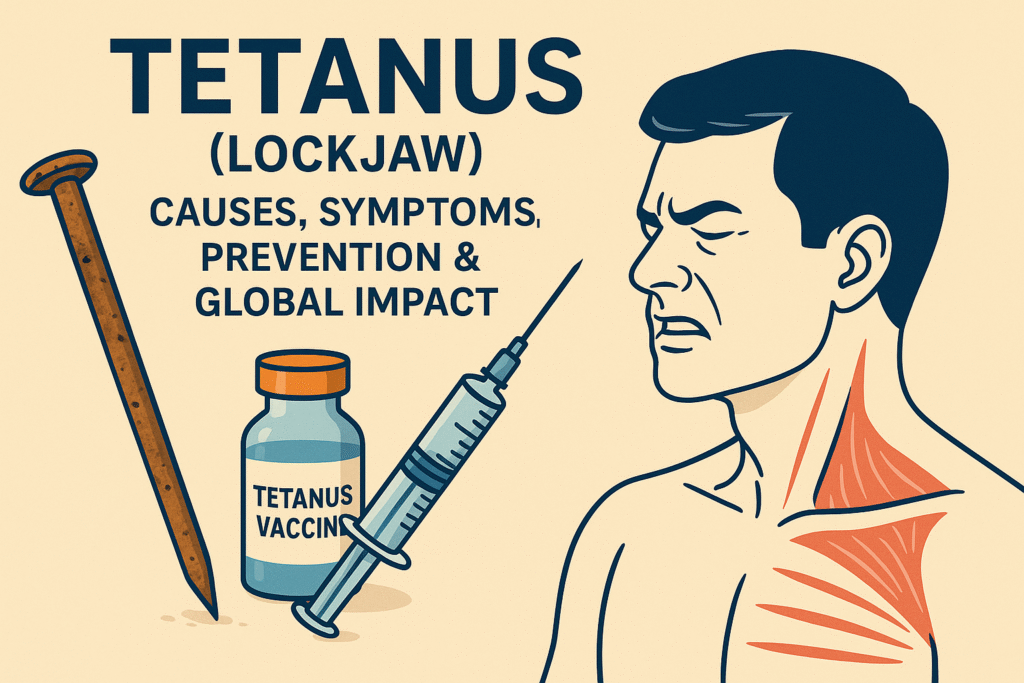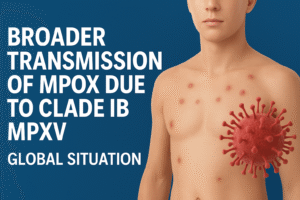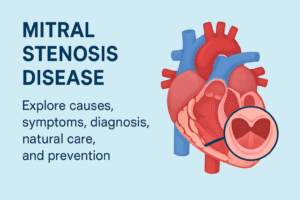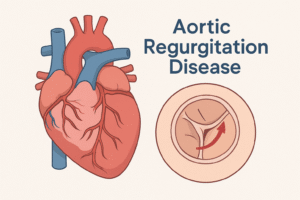Imagine stepping barefoot in your backyard in Varanasi, feeling a sudden sharp pain as you step on a rusty nail hidden in the soil. At first, it seems minor, just a small prick, but within days, your jaw stiffens, your neck muscles tighten, and even simple actions like swallowing or smiling become painful challenges. This terrifying scenario is real for those affected by tetanus, often referred to as lockjaw because one of its earliest and most distinctive symptoms is jaw stiffness.
Tetanus may be uncommon in urban hospitals, yet it still poses a serious threat in rural or under-vaccinated regions. Understanding this disease is not just about medical knowledge—it’s about protecting lives, preventing suffering, and empowering communities. In this guide, we’ll explore the causes, symptoms, prevention strategies, and global impact of tetanus, with real-life examples, actionable steps, and answers to common questions.
What is Tetanus?
Tetanus is a neurological infection caused by Clostridium tetani, a bacterium found in soil, dust, and animal feces. The bacteria release a powerful toxin called tetanospasmin, which interferes with the nervous system’s ability to control muscles. This results in painful muscle stiffness, spasms, and difficulty moving.
Unlike viral diseases like the flu, tetanus does not spread from person to person. Instead, it enters the body through cuts, puncture wounds, burns, or scratches, especially when these injuries are contaminated with soil or rust.
Imagine a farmer in Sonbhadra, cutting sugarcane without gloves. A small cut seems harmless, but the bacteria lurking in the soil can lead to a severe tetanus infection if proper precautions are not taken.
Causes of Tetanus
Preventing tetanus starts with understanding how it occurs. The main causes include:
- Puncture wounds from rusty objects – Nails, wires, or metal tools are common culprits. Rust itself isn’t harmful, but it often harbors the bacteria.
- Animal bites or scratches – Cats, dogs, or stray animals can carry Clostridium tetani on their claws or teeth.
- Burns and deep cuts – Injuries exposing underlying tissue create the perfect environment for bacterial growth.
- Unsanitary medical injections – Reusing needles or improper sterilization increases infection risk.
- Soil or manure exposure – Farmers, gardeners, and children playing outdoors are particularly vulnerable.
Tip: Even minor injuries, if untreated or exposed to dirt, can be dangerous. Cleaning a wound promptly and properly can prevent the bacteria from taking hold.
Symptoms of Tetanus
Tetanus symptoms often appear 3 to 21 days after the initial infection, starting subtly and escalating gradually. Recognizing these early signs is crucial:
- Jaw stiffness (lockjaw) – Difficulty opening the mouth is usually the first symptom.
- Neck and abdominal stiffness – Muscles tighten, causing discomfort and pain.
- Muscle spasms – Sudden, uncontrollable contractions that can last for minutes.
- Fever, sweating, and rapid heartbeat – Indicators that the body is fighting the toxin.
- Difficulty swallowing – Eating and drinking become painful.
- Severe cases – Spasms may affect breathing, leading to life-threatening complications.
Real-life example: Sunita, a student in Pune, ignored a small scratch while gardening. Within a week, she experienced jaw stiffness and painful muscle contractions. A hospital visit and prompt treatment saved her life. Stories like these highlight the importance of early detection and vaccination.
Stages of Tetanus
Understanding the stages helps in early recognition and treatment:
- Incubation Period – 3–21 days after injury, often unnoticed.
- Early Symptoms – Mild jaw stiffness, difficulty swallowing, and slight muscle tension.
- Progressive Stiffness – Neck, chest, and back muscles become rigid; pain intensifies.
- Severe Muscle Spasms – Involuntary contractions, sometimes triggered by light, sound, or touch.
- Complications – Respiratory failure, fractures from spasms, and potential death without intensive care.
Prevention of Tetanus
The most comforting fact about tetanus is that it is completely preventable. Here’s how:
- Vaccination – The tetanus vaccine is safe and effective. Children receive it as part of the routine immunization schedule. Adults need booster shots every 10 years.
- Immediate wound care – Clean any cuts or punctures thoroughly with soap and water. Apply antiseptic and cover the wound to prevent bacterial entry.
- Medical consultation – For deep or dirty wounds, doctors may recommend a tetanus booster or tetanus immune globulin.
- Protective measures during outdoor activities – Wear gloves while gardening, shoes while walking, and avoid unsafe areas.
- Community awareness – Educate family members, especially in rural areas, about early signs and vaccination schedules.
Actionable tip: Keep a small first-aid kit at home with antiseptics, sterile bandages, and updated vaccination records. This simple habit can prevent life-threatening infections.
Global Impact of Tetanus
Even in 2025, tetanus continues to claim thousands of lives annually, particularly in low- and middle-income countries:
- According to the World Health Organization (WHO), tetanus deaths are concentrated in areas with limited vaccination access.
- Neonatal tetanus remains a major concern; babies born to unvaccinated mothers are highly vulnerable.
- In countries like India, widespread vaccination programs have reduced cases dramatically, but rural pockets still face significant risks.
- Awareness campaigns, proper hygiene, and booster programs have the power to save thousands of lives each year.
FAQs About Tetanus
1. Can tetanus spread from person to person?
No. Tetanus infections occur through contaminated wounds, not through direct contact.
2. How soon do symptoms appear after infection?
Symptoms typically appear 3–21 days after the wound occurs, depending on the depth and cleanliness.
3. Is tetanus fatal?
Yes, without timely medical intervention, tetanus can lead to respiratory failure and death. Early treatment significantly improves outcomes.
4. Can vaccination protect lifelong?
Vaccination is highly effective but requires booster shots every 10 years to maintain immunity.
5. What should I do if I get a puncture wound?
Clean the wound thoroughly, apply antiseptic, and consult a doctor about tetanus vaccination or boosters.
6. Is lockjaw permanent?
No. Lockjaw is a symptom of tetanus and resolves with proper treatment and muscle relaxants.
Conclusion
Tetanus may be rare in urban areas, but its consequences can be severe and life-threatening. Awareness, vaccination, and immediate wound care are your most powerful defenses. Every small action—whether cleaning a minor cut, getting a booster, or educating your community—plays a part in preventing suffering and saving lives.
Remember: Health is your greatest wealth. Prevention is not just a choice; it is an act of love for yourself and those around you.
We work hard to bring you accurate, reliable, and engaging health information. Your feedback, suggestions, or even criticism help us improve. Every comment matters, and together, we can build a safer, healthier community.
You can read our blog on Acidity – https://newsarmour.com/acidity-acid-reflux-causes-symptoms-treatment-global-impact/
Sources ;-
WHO Tetanus page → https://www.who.int/news-room/fact-sheets/detail/tetanus
CDC Tetanus info → https://www.cdc.gov/tetanus/index.html






